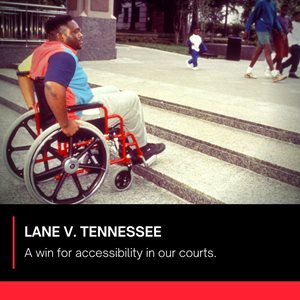Reflections on Lane v. Tennessee

Sometimes one case has multiple outcomes. Sometimes those outcomes are long lasting and have a powerful ripple effect. Lane v. Tennessee is one of those special cases that has helped many people in the years since it’s successful outcome.
The Lane v. Tennessee case was brought on behalf of six plaintiffs with mobility disabilities in the 2000’s. The case was initiated by George Lane, who was forced to crawl up the steps of a courthouse to attend his hearing. George didn’t know anything about the Americans with Disabilities Act (ADA), but he did know that what happened to him was wrong. And he wanted to make sure it didn’t happen to anyone else with a disability. So, George, in partnership with Disability Rights Tennessee (DRT), at that time called Tennessee Protection & Advocacy, Inc., filed a lawsuit.
The case went on to add five other people with mobility disabilities who had faced similar discriminatory barriers to access in the courts. One of those was Beverly Jones, a court reporter with paraplegia who had difficult accessing upstairs courtrooms in several Tennessee counties. Instead of installing an elevator or holding court on the first floor, court personnel sometimes carried Beverly to the appointed courtroom. This was both embarrassing to Beverly as well as dangerous.
In 2004 the U.S. Supreme court ruling resulted in changes to the policies and practices of Tennessee’s judicial branch. Among these changes, people with disabilities can now request disability related modifications, such as a continuance or sign language interpreting from Tennessee courts. The Court also held that despite sovereign immunity, a plaintiff can sue for ADA violations within its court program.
The impact of Lane has moved beyond these initial decisions. Because of Lane, Tennessee’s court program adopted a robust Judicial Branch ADA policy that remains in effect. This policy ensures the accessibility of court proceedings in all 95 Tennessee counties. In addition, in U.S. v. Georgia, the Supreme Court extended the analysis in Lane to state prison programs. And a more recent issue, which has not yet been considered by the Supreme Court, is whether people with disabilities who have been discriminated against by state legislatures can be compensated. At least two federal district courts have applied the Lane analysis when answering yes to this question.
The Lane case made sure that all Tennesseans with disabilities have equal access to our state’s court program. However, people with disabilities across the country have benefited from this case’s positive outcome. Thanks to the fierce advocacy of George Lane and the other plaintiffs in Lane, accessibility and equality have expanded for many people with disabilities.
Special thanks to Martie Lafferty, Director of the Accessibility Project for CREEC, for contributing this article.
